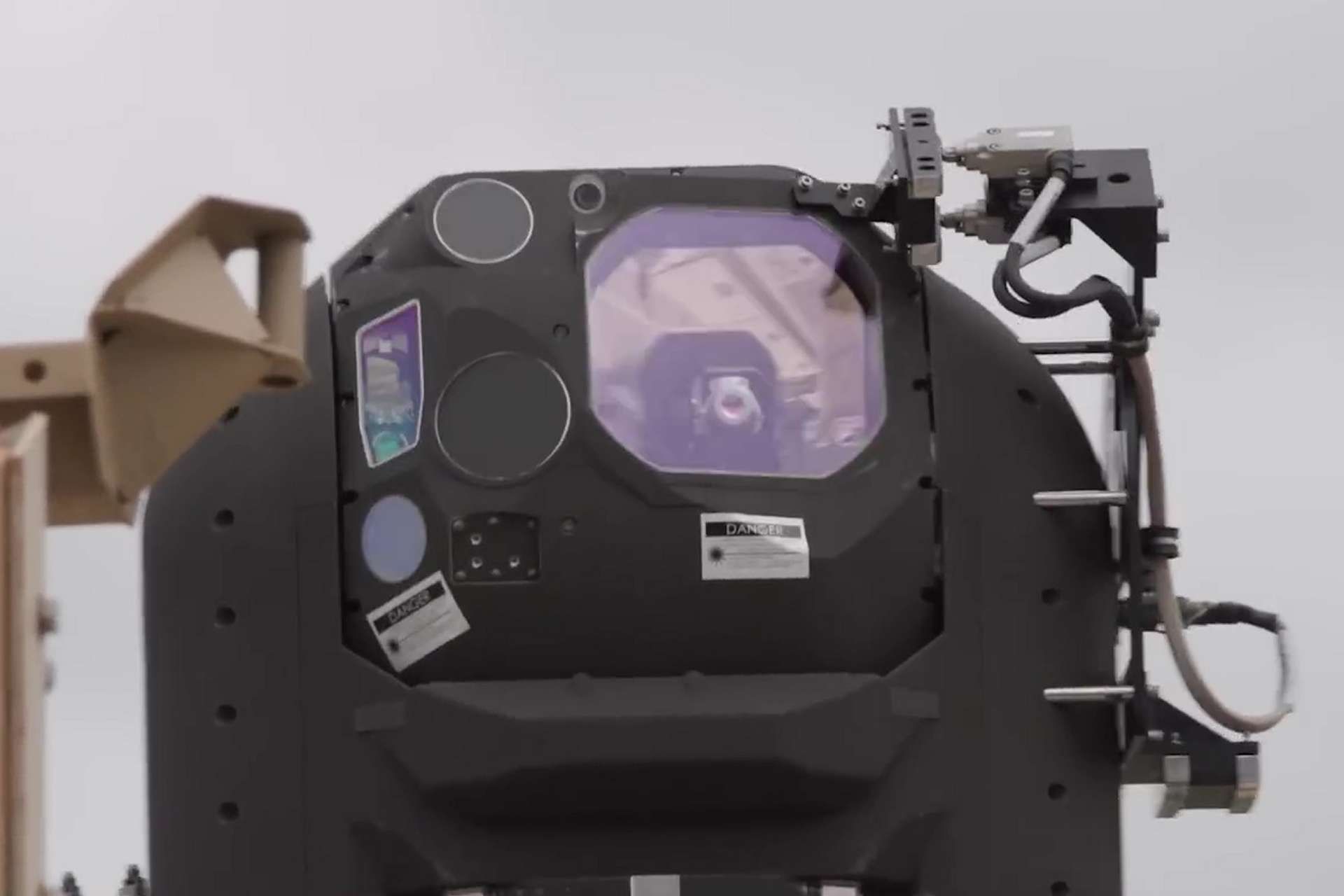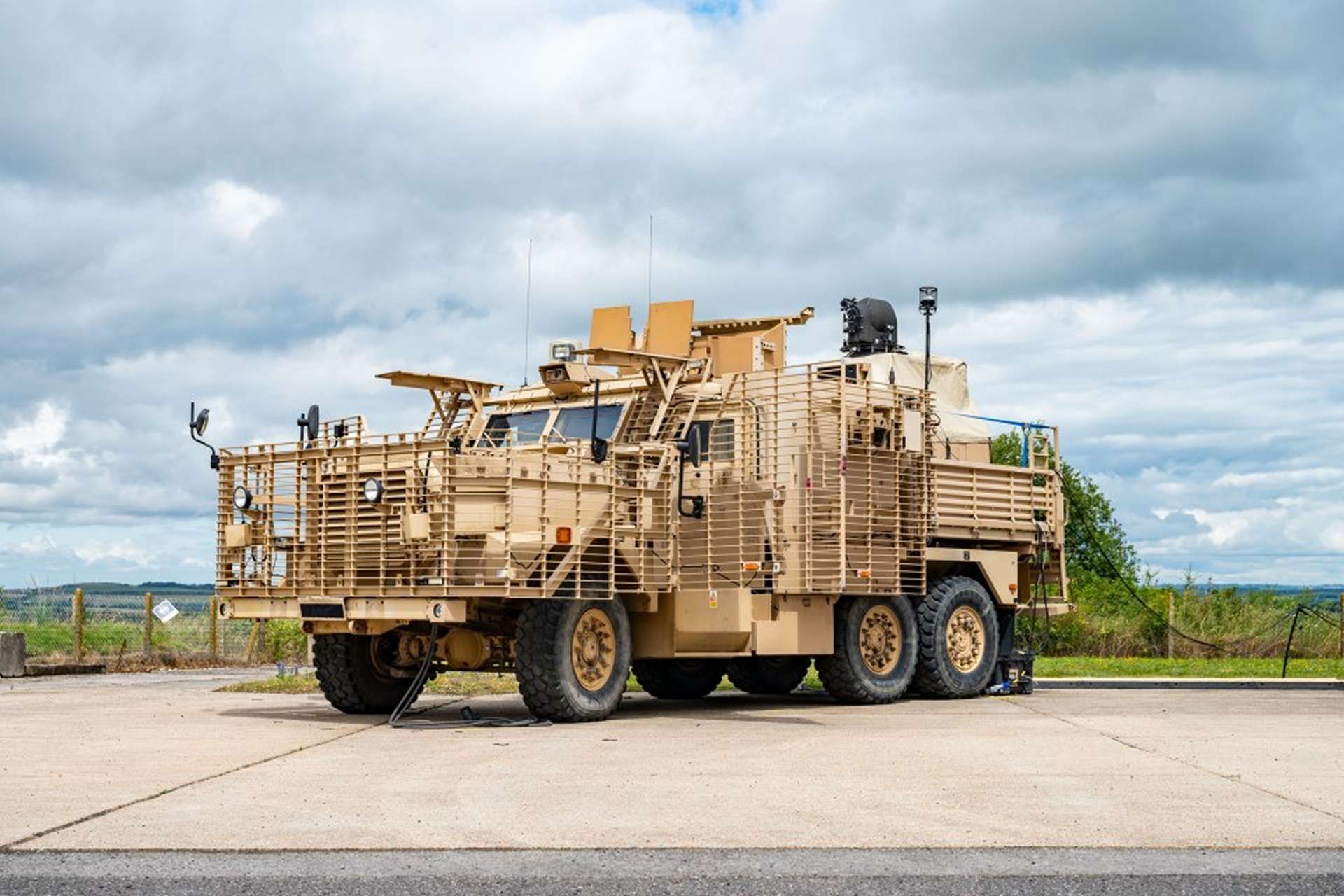Breaking News
British Army's vehicle-mounted High-Energy Laser Weapon hits one-kilometer targets in first test.
On July 22, 2024, the UK Ministry of Defence (MoD) announced the first successful test fire of a High-Energy Laser Weapon System (HELWS) from a British Army's Wolfhound 6x6 armored vehicle. This test, conducted at the Defence Science and Technology Laboratory (Dstl)’s range in Porton Down, saw the laser weapon neutralize targets at distances exceeding one kilometer. This vehicle-mounted high-energy laser weapon represents a development in the UK Ministry of Defence’s Land Laser Directed Energy Weapon (LDEW) Demonstrator program, providing operational potential on the battlefield.
Follow Army Recognition on Google News at this link

This test of a High-Energy Laser Weapon System (HELWS), conducted at the Defence Science and Technology Laboratory (Dstl)’s range in Porton Down, saw the laser weapon neutralize targets at distances exceeding one kilometer. (Picture source: UK MoD)
The lightweight and portable high-energy laser system from Raytheon UK, also known as the High-Energy Laser Weapon System (HELWS), is the first laser weapon integrated into a land vehicle to be fired in the United Kingdom. This capability demonstrator will allow the Ministry of Defence, along with the British Army, to evaluate the utility of laser-directed energy weapon (LDEW) systems against modern threats. The next phase of testing will involve trials with British Army personnel later this year to further assess the system’s capabilities in real-world scenarios. The system is described as low-cost, easy to operate, and capable of tracking multiple targets and engaging them at the speed of light.
Dstl Chief Executive Dr. Paul Hollinshead OBE MBA noted that this milestone advances the adoption of directed energy weapons. Working with DE&S and industry to develop new capabilities, the aim is to prepare the armed forces to detect, disable, and destroy future threats. Team Hersa, combining Dstl’s technical expertise with DE&S’s acquisition skills, is managing the delivery of the demonstrators to ensure the UK Armed Forces can utilize this capability quickly.
Matt Cork, Dstl Programme Lead, highlighted the collaboration between Dstl, DE&S, and industry, which enabled the rapid development of the laser demonstrator. He indicated that the successful testing marks an important moment in enhancing the British Army's future operational capabilities. The technology provides a means to address aerial threats and enhance protection for forces.

The lightweight and portable high-energy laser system from Raytheon UK, also known as the High-Energy Laser Weapon System (HELWS), is the first laser weapon integrated into a land vehicle to be fired in the United Kingdom. (Picture source: UK MoD)
Developed with UK suppliers including Raytheon UK, Frazer-Nash, NP Aerospace, LumOptica, Blighter Surveillance Systems, and Cambridge Pixel, the laser system showcases advanced technology in modern warfare. It operates with a command and control system and can be integrated with broader battle management radar and surveillance systems. The weapon can be mounted on various platforms to meet different operational needs.
James Gray, Chief Executive and Managing Director of Raytheon UK, mentioned the successful firing of the first laser weapon integrated on a land vehicle in the UK. He pointed out that the Raytheon high-energy laser weapon system can track, engage, and defeat targets while mounted on a vehicle. Gray anticipates further experiments by the British Army to confirm the technology's readiness for battlefield deployment.
The Wolfhound 6x6 armored vehicle, used as the platform for this trial, is part of the British Army's Tactical Support Vehicle program. Designed for high levels of protection and versatility, it supports frontline troops by transporting cargo under its armored chassis. Its design allows for the integration of various equipment, making it suitable for experimental defense projects like the high-powered laser weapon, demonstrating the practicality and potential effectiveness of this technology in real-world military applications.

The Wolfhound 6x6 armored vehicle, used as the platform for this trial, allows for the integration of various equipment, making it suitable for experimental defense projects. (Picture source: UK MoD)
As previously revealed by Army Recognition on February 29, 2024, Raytheon UK has contributed significantly to this technological advancement, bringing its High-Energy Laser Weapon System to the UK in partnership with several British suppliers. The system’s integration, completed in Coventry at NP Aerospace, includes a radar from Blighter Surveillance Systems and a command-and-control framework developed by Raytheon UK in Harlow. Following drone tracking trials, the system underwent live-fire acceptance tests at Dstl Porton Down before its deployment with the British Army.
Raytheon UK's laser system is versatile and portable, capable of being mounted on various platforms and interfacing with other air defense systems based on operational needs. Eight high-energy laser weapons have been delivered to the U.S. Army, demonstrating efficacy against over 400 targets across 25,000 operational hours.
The DragonFire Laser Directed Energy Weapon program, led by Dstl on behalf of the British MoD, represents another development in British laser technologies. This program uses a highly concentrated beam of light to neutralize threats, providing a cost-effective and efficient alternative to conventional ammunition. With a focus on countering hostile unmanned aerial vehicles (UAVs), the technology offers a potential solution for defense operations.
As reported by Army Recognition on April 12, 2024, the British Ministry of Defence is expediting the deployment of the DragonFire laser system, with plans to make it available to Ukraine before 2027. The system, which can hit a target as small as a pound coin from a distance of one kilometer, is undergoing further development and testing. Its operational cost-efficiency, at approximately £10 per firing, makes it a viable option for various military applications. Future plans include extending its application across different military platforms such as Royal Navy warships and potentially Royal Air Force aircraft.

The operational cost-efficiency of such laser weapon systems, at approximately £10 per firing, makes it a viable option for various military applications, mainly to shoot down enemy drones. (Picture source: UK MoD)


























